I am trying to create a graph that plots points, labels, and lines that connect the points given a start and end position. Then transform it into a polar chart. I can plot the points, labels, and lines, but my issue is when I transform my chart into polar. I have used both geom_curve and geom_segment.
In using geom_curve I get an error because geom_curve is not implemented for non-linear coordinates. Therefore the furthest I can get is this:

In using geom_segment I get it closer to my desired effect, but it draws the lines along the cirlce's circumfrence, which makes sense given how I pass through the coordinates. Here is a photo:

I essentially need a geom_curve for polar coordinates, but I have been unable to find one. I would like the lines on the inside of the circle and curved, there will be some overlap but anyway suggestions it look nice with spacing or something would be welcomed.
Data:
k<-18
ct<-12
q<-6
x_vector1<-seq(1,k,1)
x_vector2<-seq(1,3,1)
x_vector3<-seq(k-2,k,1)
x_vector<-c(x_vector1,x_vector2,x_vector3)
n<-9 ## sets first level radius
radius1<-rep(n,k)
b<-13 ## sets second level radius
radius2<-rep(b,q)
radius<-c(radius1,radius2)
name<-c('Alice','Bob','Charlie','D','E','F','G','H','I','J','K','L',
'M','N','O','Peter','Quin','Roger','Alice2','Bob2','Charlie2',
'Peter2','Quin2','Roger2')
dframe<-data.frame(x_vector,radius,name)
dframe$label_radius<-dframe$radius+1
from<-c('Alice2','Bob','Charlie','D','E','Alice2','Charlie2','Charlie',
'I','J','K','L','M','N','O','Peter','Quin','Alice')
to<-c('Alice','Alice','Alice','Alice','Alice','Bob',
'Bob','Bob','Bob','Charlie','Charlie','Peter',
'Peter','Quin','Quin','Quin','Roger','Roger')
amt<-c(3,8,8,8,6,2,2,4,2,4,8,1,10,5,9,5,2,1)
linethick<-c(0.34,0.91,0.91,0.91,0.68,0.23,0.23,0.45,0.23,0.45,
0.91,0.11,1.14,0.57,1.02,0.57,0.23,0.11)
to_x<-c(1,1,1,1,1,2,2,2,2,3,3,16,16,17,17,17,18,18)
to_rad<-c(9,9,9,9,9,9,9,9,9,9,9,9,9,9,9,9,9,9)
from_x<-c(1,2,3,4,5,1,3,3,9,10,11,12,13,14,15,16,17,1)
from_rad<-c(13,9,9,9,9,13,13,9,9,9,9,9,9,9,9,9,9,9)
stats<-data.frame(from,to,amt,linethick,to_x,to_rad,from_x,from_rad)
p<-ggplot()+
geom_point(data=dframe,aes(x=x_vector,y=radius),size=3,shape=19)+
geom_text(data=dframe,aes(x=x_vector,y=label_radius,label=name))+
geom_segment(data=stats,aes(x=from_x,y=from_rad,xend=to_x,yend=to_rad, color=to), ## I need arrows starting at TO and going to FROM. ##
arrow=arrow(angle=15,ends='first',length=unit(0.03,'npc'), type='closed'))+
## transform into polar coordinates coord_polar(theta='x',start=0,direction=-1)
## sets up the scale to display from 0 to 7 scale_y_continuous(limits=c(0,14))+
## Used to 'push' the points so all 'k' show up. expand_limits(x=0) p

